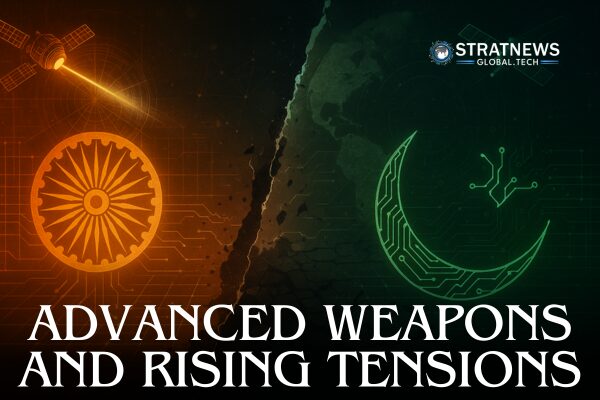The India-Pakistan conflict has demonstrated significant advances in military technology, deploying a broad spectrum of modern weapon systems that reflect years of strategic investment and global defence partnerships. This latest phase of their conflict has moved beyond conventional skirmishes, with precision-guided munitions, loitering drones, and next-generation missile defence systems now shaping the contours of the conflict.
India’s High-Tech Military Deployments
India’s operations, particularly under the banner of “Operation Sindoor,” have seen the first wartime deployment of several sophisticated platforms. These technologies underscore New Delhi’s growing emphasis on rapid, precision-based force projection.
Harop Loitering Munitions (Israel)
India deployed Harop loitering munitions of Israel Aerospace Industries, in coordinated strikes aimed at disabling Pakistani air defence systems, including installations near Lahore. These suicide drones are designed to hover over a target area before diving onto identified threats. While Pakistani sources claim to have downed 25 such drones, with wreckage found in multiple regions, the scale and coordination of these attacks suggest a broader integration of unmanned systems into India’s offensive doctrine.
S-400 ‘Sudarshan’ Air Defence System (Russia)
In a notable first, India’s Russian-supplied S-400 system—codenamed ‘Sudarshan’—was activated in combat. Positioned near key northern cities, the S-400 successfully intercepted multiple Pakistani drones and missiles targeting Amritsar, Jammu, and adjoining sectors. Its radar-guided surface-to-air missiles gave India a robust shield against high-altitude and stealth threats, significantly enhancing its air defence grid.
Rafale Fighter Jets with SCALP and HAMMER Missiles (France)
India’s French-built Rafale fighters, equipped with SCALP cruise missiles and HAMMER precision-guided bombs, spearheaded cross-border strikes on militant infrastructure in Pakistan Occupied Kashmir and Punjab. These precision strikes have drawn international attention, not just for their effectiveness, but also for the strategic restraint with which they were executed—targeting high-value assets while avoiding civilian areas.
Agni-P Ballistic Missile (India)
While not confirmed in combat, the indigenous Agni-P ballistic missile remains a key part of India’s strategic deterrent. With manoeuvrable reentry vehicle (MaRV) capability and improved road mobility, it adds a credible second-strike advantage in the event of broader escalation.
Pakistan’s Technological Countermeasures
Islamabad has responded with its own array of advanced military platforms, relying heavily on systems procured from China and domestically modified assets. Pakistan’s defence strategy appears to be centred on area denial, deterrence, and targeted aerial engagements.
J-10C Fighter Jets with PL-15 Missiles (China)
Pakistan deployed J-10C fighter jets armed with long-range PL-15 air-to-air missiles. The PL-15, with its active radar homing and extended range, is designed to challenge even fifth-generation aircraft.
HQ-9 Air Defence System (China)
To defend against Indian aerial strikes, Pakistan has relied on its HQ-9 long-range surface-to-air missile systems. Positioned near key military and civilian installations, the HQ-9 does not appear to have been particularly effective. Lahore air defence system was reportedly destroyed in an Indian strike.
Abdali Short-Range Ballistic Missile (Pakistan)
Pakistan test-fired its Abdali short-range missile during heightened tensions. The solid-fuelled missile, with a range of 180–200 km, is capable of carrying both conventional and nuclear warheads. The move was widely interpreted as a signal of strategic preparedness.
Emerging Frontiers in the India–Pakistan Conflict
Drone Warfare as a New Frontline
Both India and Pakistan have increasingly turned to unmanned aerial vehicles (UAVs) for surveillance and combat operations. The scale of drone usage in the current conflict reflects a shift toward networked, unmanned systems capable of operating in contested environments with minimal human risk.
Electronic Warfare and Cyber Disruption
Though publicly undisclosed, defence analysts believe both sides are actively employing electronic warfare (EW) tools to disrupt communications and radar systems. Cyber operations targeting command-and-control infrastructure are also likely underway, borrowing tactics observed in recent global conflicts.
Strategic Risks and Global Concerns
The use of cutting-edge military hardware by two nuclear-armed nations has significantly raised the stakes in South Asia. The introduction of precision-guided weaponry, long-range missiles, and electronic warfare systems has transformed this from a conventional standoff into a theatre of high-technology conflict.
International observers, including the United Nations and regional allies, have called for urgent de-escalation and the reopening of military and diplomatic communication lines. The possibility of miscalculation in such a rapidly evolving combat scenario remains a critical concern, especially given the strategic weapons on standby.
As both countries demonstrate their military advancements, the 2025 India–Pakistan conflict serves as a stark reminder of the fine line between tactical superiority and strategic overreach. The path to peace now rests not only on military restraint but also on the willingness of both nations to engage in sustained, meaningful dialogue before the costs of escalation become irreversible.


